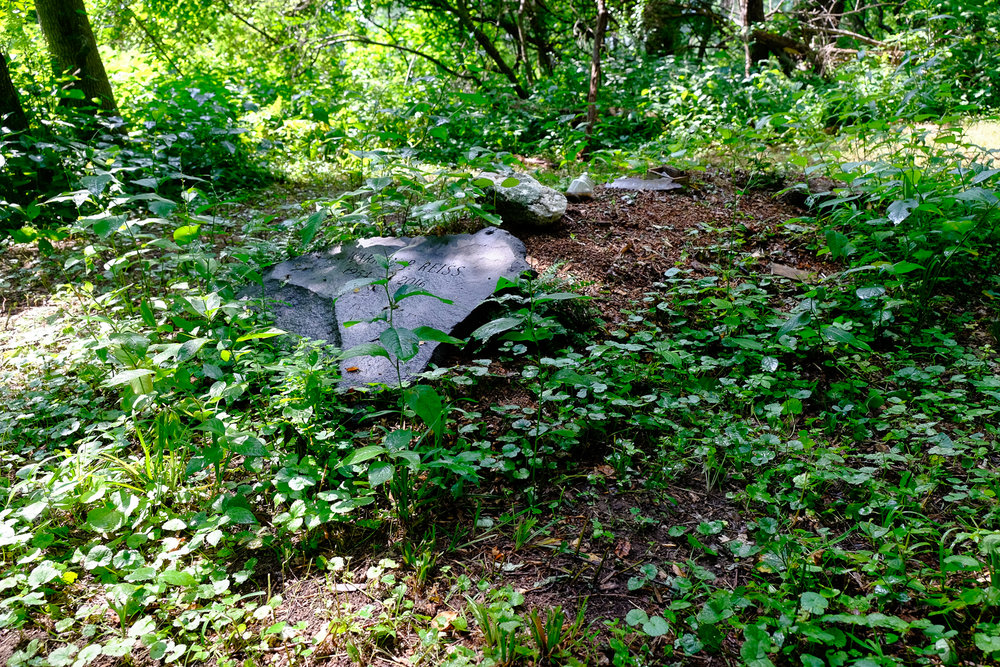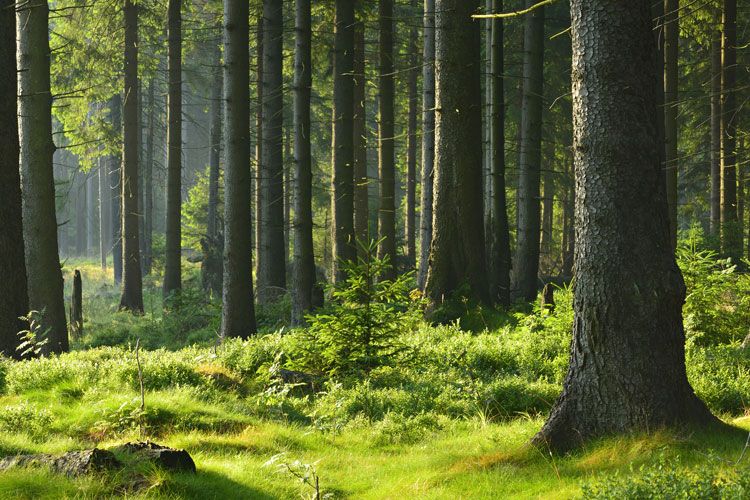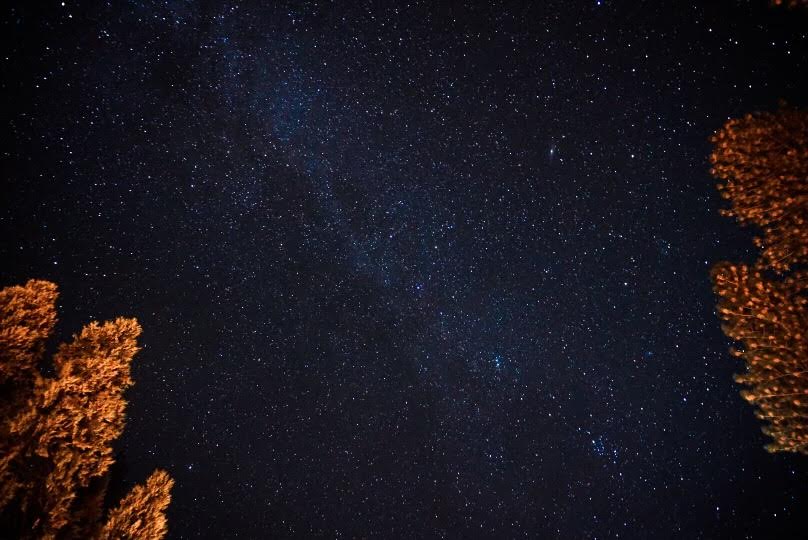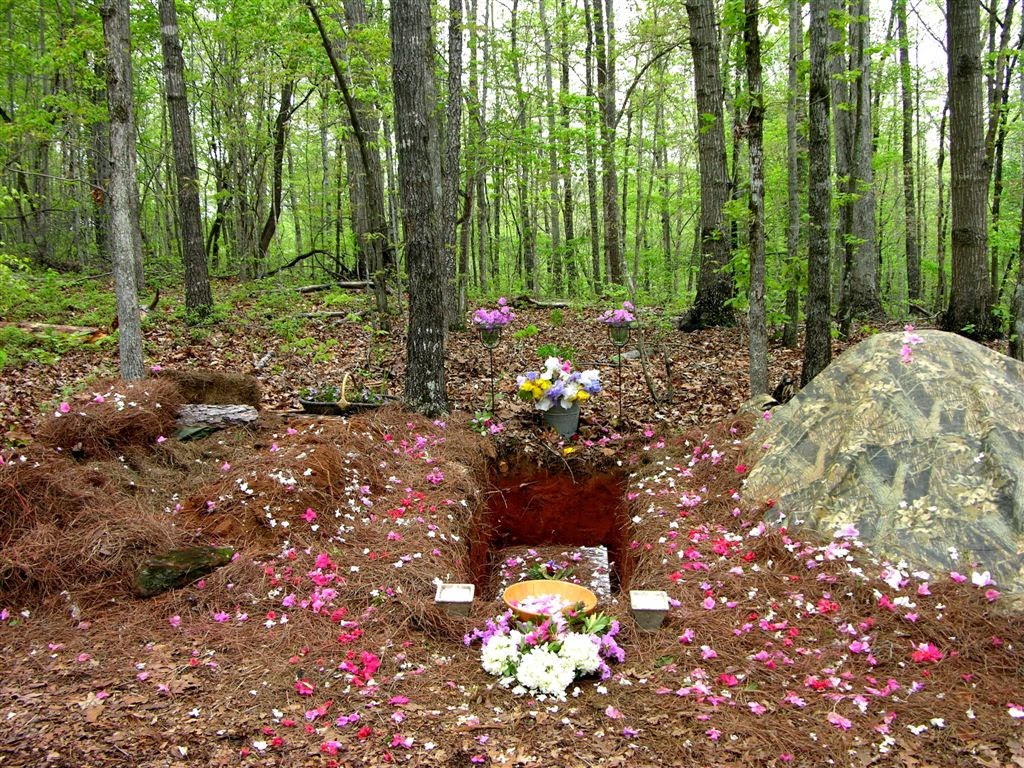Listen to an audio version of this article on our podcast, Death in the Afternoon.
In 1889, over 100 years before the first conservation cemetery was founded in the United States, a man who was just beginning his journey to become “The Father of Environmentalism” sat deflated in a high mountain pasture in the Sierra Nevada Mountain Range. John Muir had emerged from his campsite, furious to see the devastation that a flock of sheep had wrought on the grassland of this “cathedral” of mountains. He drew a line on a map through the Sierra Nevada Mountain Range to outline the piece of wilderness he hoped to call Yosemite National Park. Muir seemed not to notice, Yosemite already had a name: “Awahnee” meaning “gaping mouth-like place” named by the Awahneechee people who lived in the grand valley of the mountains. Years earlier, in the 1850’s, the Awahneechee people were massacred when a group of white men set fire to their wigwams. What Muir defined as a place of true “wilderness” where “no mark of man is visible” had already been a space of community, harmonious with the Land. That is, until the Land was forcibly taken from them.

This is only one example of how environmentalism has the propensity to overlook and exclude the histories and cultures of marginalized populations who do not fit neatly into their narrative. In the 21st century, we are only just beginning to unpack these harmful ideas, formed in the name of good will and science. Part of this unpacking process compels us to discuss the Green Burial movement. The movement emerged in the early 1990s, as part of a larger countermovement addressing the dissatisfaction some felt with the American way of death (known for being manipulative, corporatized, stuffy, and needlessly expensive). Green Burial, takes a few different forms, but mainly is understood to be the burial of a body that is not chemically embalmed and is placed directly into the Earth in a compostable coffin or shroud. The movement takes a political tone when it lobbies the government for changes in regulations for funeral homes and cemeteries, and much of its focus is on issues of climate change and sustainability. It is therefore viewed as a part of the larger environmental movement that has been active in the United States since the 1960s.
I report on this movement as a white woman who has traveled in select Green Burial business/activism circles for a few years now, and these circles are majority white. I am not the first person nor the last to point out this uncomfortable fact. There is no doubt this can lead our advocacy to be oblivious to the issues our BIPOC counterparts experience daily. For example, we don’t often talk about why it might be hurtful to a Black family to denounce embalming and post-mortem restoration/reconstruction. We don’t often consider that it might be triggering to a Jewish or Armenian family when we suggest an unmarked grave in the woods. The Green Burial Movement has largely overlooked Indigenous people who have long been practicing burial in a sustainable way, and that their traditions are deeply rooted in the relationality of their cultures, which have since been erased in the name of science and environmentalism. I’m not suggesting the Green Burial movement is openly hostile to these groups, but I am saying we can often miss the mark in understanding the deep and emotional legacies that are present in views of the body and burial.
The term I find most apt here was coined by Anthropologist Franz Boas. “Ethnocentrism” which is defined in the Oxford dictionary as the “evaluation of other cultures according to preconceptions originating in the standards and customs of one’s own culture.” Michelle Acciavatti, who is a Funeral Director at Ending Well and President of Vermont Natural Burial spoke with me about having to reassess her experiences in the Green Burial world through the lens of ethnocentrism.
“I’ve been training for 7 years and there’s just a lot about what I was taught that totally erases a huge portion of the people involved in the Green Burial world. My training has all been done by primarily white women of a certain age. There’s been very little cultural diversity. […] I’m realizing that I have to unlearn so much of the foundational stuff that I was taught because it erases and leaves out so much history.”
Sometimes this erasure can be purposeful, like in the case of Yosemite National Park and the Awahneechee, but much of the time it is merely a byproduct of a primarily white and Western world view that has codified it’s experiences as universal. Acciavatti again:
“When describing natural burial we often revert to using language like ‘it’s burial just like it was before the Civil War’ as if that’s a really great and wonderful time to go back to. […]We don’t examine that we talk about home funerals as if we’re returning to this type of deathcare, but there are cultures that have never actually lost home deathcare. A lot of traditional religions (whether it’s Islam or Judaism, and even aspects of Christianity) they still very much take care of the body themselves. Additionally, there are a lot of people that come as immigrants or migrant workers and keeping the body at home and not working with a funeral director is part of their culture. These are just a few examples of groups of people who do not have to reintroduce natural burial to their communities, so when we frame the issue as a reintroduction it’s clear that we’re talking about and talking to a white community, but we never call that out as something that is specific to the white community.”
Race and Embalming/Post-Mortem Reconstruction
In her article “Race & The Funeral Profession; What Jessica Mitford Missed” Dr. Kami Fletcher illuminates how ubiquitous it is for white death industry professionals or experts to gloss over the vastly different experiences of communities of varying ethnicities. Jessica Mitford’s book, The American Way of Death published in 1963, has informed and directed the battle-cry of Green Burial activists in a way that perhaps no other book has. And yet, Jessica Mitford’s book exposed the corruption of the funeral industry as if it were a universal monolith.
“Just who were these American funeral directors that Mitford tried and found guilty in a public court of opinion? From 1900-1960’s, the initial study period of her book, who were viewed as American funeral directors? It definitely was not the African American funeral director because she/he was living under Jim Crow segregation – barred based on race from even obtaining membership in the National Funeral Directors Association. […] African American funeral directors led the charge in the Civil Rights Movement by using their funeral parlors as meeting places. They threatened not to buy their funeral cars from white establishments if they didn’t hire African American workers. African American funeral directors bailed-out jailed protesters. […] [They] fought for justice; they did not have time to collectively concoct schemes to exploit the bereaved” (Fletcher, “Race and the Funeral Profession”).
This is not to say that the premise of Mitford’s book is incorrect, but rather to demonstrate how white activists may unconsciously consume information that leaves out large parts of the narrative of marginalized people. As presented in The American Way of Death, funeral industry methods like embalming are presented as a moral depravity to be fought against. Activists often fall into the trap of broader character judgements like, “embalming is morally wrong.” But what about the times when embalming is actually resistance and social justice?
“The job of the African American undertaker was to take care of the body with dignity and respect. He/She had to make the police officer’s bullet holes disappear, hide the rope marks from the lynching, the infinite bruises from the KKK terrorists. An open casket funeral is a staple in the African American funeral tradition; funeral goers expect for their loved ones to look just like themselves” (Fletcher, “Race and the Funeral Profession”).
When ethnic violence and genocide is not a collectively shared part of one’s history it is easier to overlook the importance of postmortem restorative procedures in the death customs of cultures who do have that tragic shared history. Sarah Wambold of the Campo de Estrellas Conservation Cemetery in East Texas spoke about this in more detail.
“Those of us who work in this type of deathcare must do more to consider the ways in which natural burial repackages what for some groups has been about dispossession of land and of legacy. This revision is its own type of appropriation. We must acknowledge the revision and privilege of calling what is essentially an unmarked grave ‘natural burial’ because we know our legacy is intact.”

Unmarked Graves and Genocide Survivors
The issue of legacy and memorialization is another hurdle that most Green Burial cemeteries need to overcome. Much of the anxiety surrounding death has to do with legacy and being remembered. To Green Burial activists, gravestone memorialization often goes against the whole premise of Green Burial– leaving no trace upon the Earth. But just repeating that line does nothing to reckon with the anxieties held by those who carry the burden of a cultural history where they were denied material expressions of legacy like gravestones.
When the Eastern European Jews returned to their homes after the Holocaust they now had to deal with the aftermath of unmarked mass graves, where Jewish people were discarded with no respect to their traditional burial customs. Researcher, Sarah Garibova writes,
“Throughout the postwar decades, survivors strove to bring their relatives “to a Jewish grave”—in other words, to provide them a burial consistent with Jewish burial norms.[…] Although grave exhumation is generally prohibited in Jewish tradition, Soviet Jews did not embrace exhumation out of religious ignorance, but instead performed them out of a desire to approximate traditional Jewish burial norms under novel, catastrophic circumstances. The site was located on land that the Soviet state recognized as Jewish burial ground and the victims were already interred alongside the graves of their ancestors—conditions that fulfilled two of the major imperatives of traditional Jewish burial culture. All that remained was for survivors to cover over the exposed bones and erect a grave marker—steps intended to protect the remains from view and safeguard them against future disturbance” (Garibova, “To Protect and Preserve”).
Although there is no Jewish law requiring the marking of the grave, “matzevot” (markers of wood or stone) have been a “part of European Jewish Cemetery tradition for more than a thousand years”. This history is made even more complicated and sensitive by the Holocaust, which resulted in the unmarked mass graves of millions of people. When conservation cemetery sales people from a Christian or nonreligious background speak to Jewish families who are uneasy about the lack of a grave marker, they must acknowledge this trauma, instead of dismissing it as “not understanding the point” of conservation burial.

The Othering Language of Science
In 1970 at the first Earth Day celebration, a group of Indigenous people attempted to disrupt the proceedings, claiming that white activists had sidestepped the Chippewa tribe in policy-making decisions that directly concerned them. Senator Gaylord Nelson, one of the sponsors and organizers of the event, had spent 10 years attempting to absorb Red Cliff and Bad River reservations into the Apostle Island National Lakeshore in Wisconsin. According to Professor Dorceta Taylor’s report on Diversity in Environmental Organizations,
“Some White environmentalists perceived Native American attempts to link social justice with environmental affairs to prevent the conversion of parts of their reservation into public parks as anti-environmental. Park advocates did not understand the significance of tribal sovereignty or the reasons why tribes insisted on control of their homelands” (Taylor, “Diversity in Environmental Organizations”).
To the white environmentalists of the 1960s and onwards, caring for the Earth did not offer any grey area. The goal was to establish more protected lands, it did not matter if that land was occupied by Indigenous people who had been and would continue to live in a sustainable way. In their minds, restricting the land was protecting the land. Groups seeking to insert social justice into the mix of environmentalism were largely ignored or purposefully pushed out. As we see even now, racist views were obfuscated behind numbers and statistics and pitched to white environmentalists as irrefutable science.
Just like in the early environmental movement, there exists a subtle, yet purposeful inclination to justify the need for Green Burial in the language of science, a supposedly impartial judge of right and wrong. Calculations of figures like carbon footprints, chemical half-lifes, and decomposition timelines have led us down the exhilarating road of divine right through scientific discovery, but what we fail to rectify when we sell our plots is the deeply personal, existential, and relational choices of those who have already discovered this path. In an interview with the Ernest Becker Foundation, Sheldon Spotted Elk, speaks of the tendency to use the language of science to erase,
“In Western society, […] the whole idea of science is for us to come to the “one truth.” Whereas in Cheyenne philosophy, it’s ok to have two different perspectives on the truth, and both can be right. To be clear, I’m not anti-science, I’m pro-science, but I think this influences Western society to really create a mentality of “I’m right, you’re wrong, I’m sophisticated you’re unsophisticated, I’m civilized you’re uncivilized”—these clear markers that make it easier to discriminate.”

In the movement’s attempt to sell this type of burial to a broader public, we have relied heavily on the argument that anything other than Green Burial is a moral compromise at the expense of the environment. In doing so, we have largely failed to meet people where they are, and reconciled with sympathy and open-mindedness that cultural traditions are not created in a vacuum.
When the battle-cry of the movement is “embalming is toxic,” even with the scientific truth behind this statement, does this really create a comfortable environment for a Black mother looking to hold a funeral for her son after a police officer stood on his neck for nine minutes? When monumentation and headstones are so quickly dismissed as antithetical to Green Burial activism, would this not confuse and trouble a Jewish family, who have been practicing Green Burial for generations and desire a physical monument to their legacy? When an Indigenous person gets a newsletter in their inbox about the “revolution” in death-care, does that leave a bitter taste in their mouth? The answers to these questions are not always uniform, because people organized through identity are individuals, and not a monolith. For us as white people involved in Green Burial activism, it is not our duty to answer these questions –only to consider them, listen with an open mind, and use history as our guiding light in informing the context of the words we choose to use.
When I die, I want a Green Burial. Green burial and other sustainable initiatives are also the direction I hope the world moves toward to combat climate change. When climate change ravages communities it won’t be the wealthy and white communities who suffer. Black and brown people will disproportionately feel the consequences of our inaction, yet how we talk about the issues of environmentalism centers a white audience. We need to be more inclusive in the way we talk about Green Burial, because social justice has always demanded that from environmentalism, but so rarely have white environmentalists ever risen to the occasion.
Corinne Elicona is the Events & Outreach Coordinator at Mount Auburn Cemetery in Cambridge, Massachusetts. She curates Mount Auburn’s death positive programming, online video content, and historic walking tours of the grounds. She has written for NursingClio.org and currently writes and researches a blog series on New England burial grounds called Beyond the Gates. She is a Green Burial advocate and is also Mount Auburn’s first female crematory operator in their near 190 year history. Twitter: @CorinneElicona Instagram: @SoundAffects
The Collective for Radical Death Studies is a nonprofit organization whose members view death work as synonymous with anti-racism work. The Collective actively works toward dismantling oppression, centering the experiences of marginalized peoples, and decolonizing death in study, practice, and experience.

